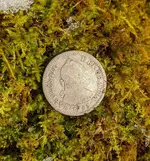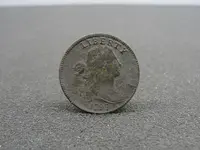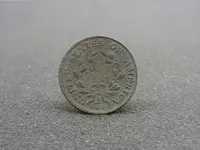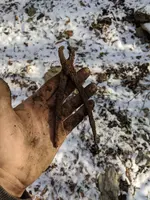paleomaxx
Hero Member
- Joined
- Aug 14, 2016
- Messages
- 841
- Reaction score
- 6,888
- Golden Thread
- 6
- Location
- Upstate, NY
- 🥇 Banner finds
- 6
- Detector(s) used
- Deus XP
- Primary Interest:
- All Treasure Hunting
This is it, this is the spot I've been searching for all 2020! I seem to find just one spot like this a year where everything comes together perfectly. Colonial homestead that's not buried by brush or developed on, soil that's kind to coppers, target rich, and best of all never been hunted before!
It really was a one in a million shot too. I got permission to check out an old roadway next to a creek that used to be the main road. Nothing on the 1850's maps, but this part of the town was settled pretty early so I was gambling that there might be an older house that was abandoned prior to the maps being drawn up. Sure enough, about a half mile down there was an odd rise a little off to the side:
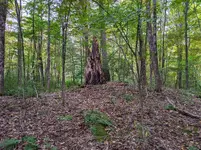
Swung my way up to it and initially there wasn't much in the way of signals, but there was a bowl-like depression on the other side of the hill and a pile of rocks that the old rotted out tree was growing out of.
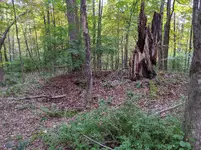
Nothing was jumping out at me brick or pottery wise, but I did a slower scan in the bowl anyways and got a few iron tones that I dug after. Sure enough they were rosehead nails. I continued scanning and towards the top of the flat area I finally got a mid tone and pulled out a crusty pewter button. Shortly after that another button, and then another, and now I was cooking! A few hours later nearly every one of my containers and baggies were overflowing with colonial relics and coins!
It took awhile for the first coin to show up, but it was a copper slick practically on the surface. Despite that, the patina was even and best of all not flaky which bode well. My optimism was confirmed shortly after when I pulled out a Connecticut copper in practically mint condition:
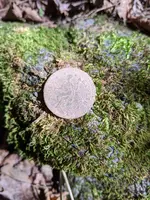
It was next to the rock pile which I now think is almost certainly the remains of the stone hearth. I went a little slower in that spot since there were a few surface buttons also, and before I knew it I was pulling out coppers left and right! In this little spot no larger than 2 feet by 3 feet I've found 9 coppers so far and I have no doubt there are more:
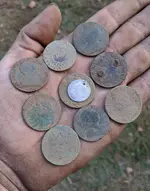
Everything in my hand (besides the Spanish silver) was in that little patch and what would happen is I would dig out one copper, re-scan the hole, and then pull out another under it. Part of the issue is the ground is bone dry around here and between that and the number of nail signals, the Deus can't get down below 4 inches. Just to see what would happen I scraped out a small test hole and pulled out a large flat rock. Under that rock were two more coppers, a tombac, and a musket ball but none of that was registering from the surface.
My theory is that there was a small cache tucked in the hearth and when it all collapsed they were spread out in this little area. Fingers crossed that when I go back with my sifter I'll find even more!
Besides the coppers I was blown away by the relics. There were multiple fantastic shoe buckle fragments:
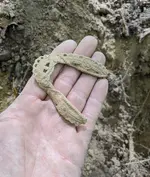
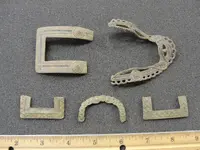
That pewter one is simply stunning, and it was almost 10 inches down. I was finding buttons all over the place too:
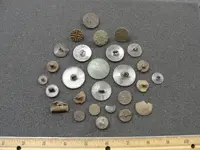
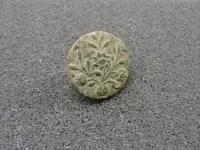
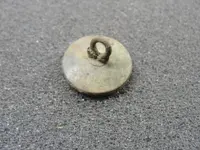
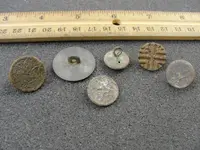
The floral one is a first for me since it's a two-piece tombac. It's not a blowhole button (as I actually found one of those at this site too) but two pieces of tombac ground flat and then bonded together somehow. Completely unique in my collection and very decorative for that time. I found one drilled shank tombac as well as plenty of spun back examples too. There were pewter buttons everywhere and many still had visible designs, but one takes the cake:
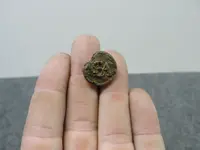
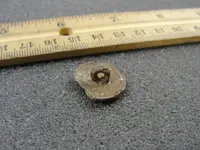
Yup, my first USA button!!! I have been looking for one of these almost since I started and I am beyond thrilled to have finally pulled one out of the ground. Little bit of ground crumbling, but I sealed it quickly and the shank survived so overall a pretty solid example. I'm also really hoping there are more around too!
I have been looking for one of these almost since I started and I am beyond thrilled to have finally pulled one out of the ground. Little bit of ground crumbling, but I sealed it quickly and the shank survived so overall a pretty solid example. I'm also really hoping there are more around too!
I spent quite a lot of time cleaning the copper coins; partly because I've never found this many at one time, but also because the preservation was fantastic on almost every single one. I worked with a bamboo skewer periodically whittled sharp to remove just enough of the dirt to keep the features bold. Zero water and an Andre's brush was used sparingly on just the most stubborn spots. As for the results, well, get ready for lots of coin photos:
First the State coppers...
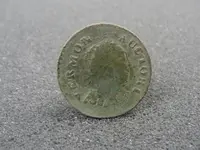
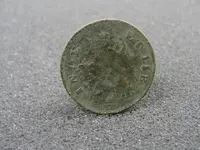
Only one Vermont copper, a 1788 Ryder-16. Common variety, but fantastic detail on both the obverse and reverse with even the small date visible. The features on the face look smoothed, but that's actually because the die for this coin was truly terrible and didn't even have basic facial features. It's actually believed that Vermont coppers in 1788 were being minted not in Vermont, but at Machin's mills in New York which may account for the general light weight and poor quality of most 1788 varieties.
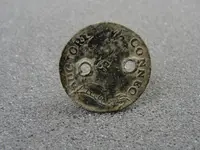
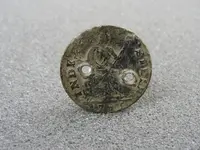
Next we have a 1785 Connecticut copper, Miller 6.4-I. Another common variety, but it looks like this one was fashioned into a whizzer. Usually teeth would also have been cut into the edge to make the sound, but maybe the kid got bored or spent it before they finished it.
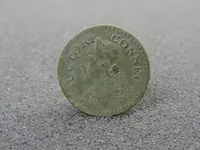
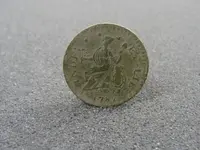
This 1787 Connecticut copper one is probably the best preserved out of all the coins dug so far. It's a Miller 6.1-M, the "laughing head" variety. Also common, but the level of detail makes this a rare piece since only the premium examples in collections have the features this clear.
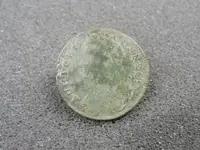
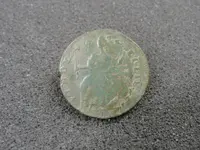
Slightly more worn 1787 Connecticut copper, but the variety is Miller 17-g.3 which is scarce.
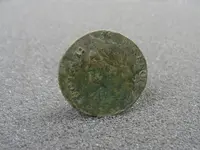
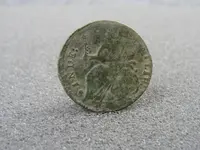
This one is a real find. 1787 Connecticut copper, but a Miller 33.17-gg.2 which is R-5; rare! Less than 75 examples known and this is in spectacular shape for any of the known examples, much less a dug coin!
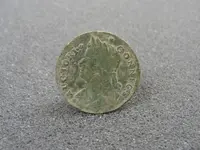
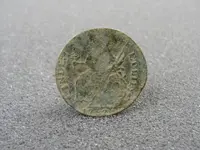
And last, but certainly not least, another rare 1787 Connecticut copper: Miller 33.19-Z.2, also R-5 with less than 75 known examples! Once again spectacular shape and you can even see the "I" in "Auctori" was stamped twice on the die which is diagnostic of this obverse.
Now on to the British coppers:
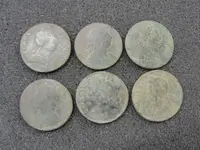
There were six identifiable British halfpennies, but I suspect that first slick is a William III halfpenny due to the right facing bust and lack of a rim that would be seen on a George I. Unfortunately it's pretty much impossible to tell for sure, so I can't say I found a 17th century coin here but considering the condition of the rest I can let this slide.
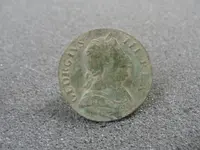
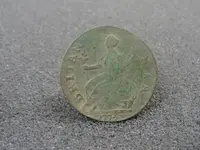
Full weight 1775 King George III half penny.
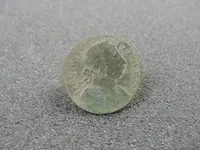
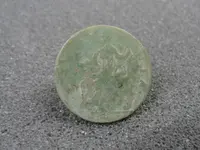
Practically paper-thin counterfeit 1775 KGIII half penny. Doesn't match the Machin's Mills die so probably a British-made counterfeit.
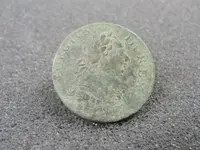
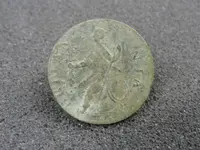
This one I'm not sure on. The weight is either spot-on or only slightly light but the "N" on the obverse looks wrong and the date was very weak. Pretty sure it was 1773, but it's odd that it wore off and the rest of the features are pretty sharp.
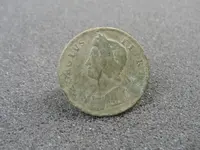
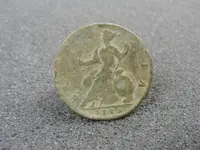
This one was a surprise, a 1729 King George II half penny, the first year of issue! This is an OLD coin for this area and surprisingly good shape considering its age.
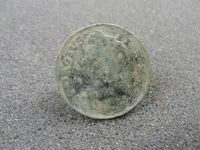
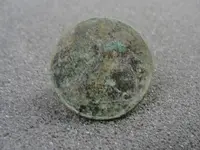
Not a lot to see on this KGII halfpenny, but I actually think it's a cast counterfeit based on how blocky and irregular the lettering is.
And finally for the best coin (so far):
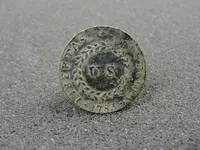
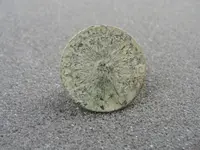
A 1783 Nova Constellatio, Crosby 2-B!!! The obverse is fantastic, although the reverse took a beating. It's actually just a layer of chalky patina over the harder black patina, but I haven't figured out a way to take one off of the finer details without removing both. For now I'll leave it alone, but I might be able to get that looking even better after some practice on a less rare early American copper!
The obverse is fantastic, although the reverse took a beating. It's actually just a layer of chalky patina over the harder black patina, but I haven't figured out a way to take one off of the finer details without removing both. For now I'll leave it alone, but I might be able to get that looking even better after some practice on a less rare early American copper!
And finally I did manage one colonial silver, a 1782 half real from the Mexico City mint:
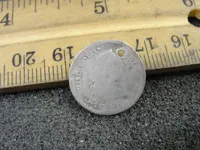
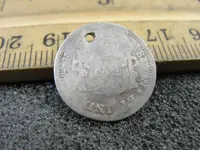
Here's a group shot of the coins so far:
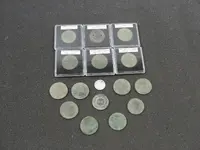
Pretty awesome cross-section of what was in circulation during and after the Revolution. Based on the buttons I'm thinking this site was occupied from sometime in the 1760's to ~1790. After I showed the finds to the landowner they mentioned that there's a small family graveyard about 400 feet from where the homesite was. I hiked out to it and recorded the names and dates on the headstones. There are three different family names and one is a known Revolutionary War veteran so with the USA button there's a good chance this was their house, but I'll have to do some more detective work to see if I can confirm that with deeds or other records. Although if I can dig up a spoon with an engraved name that would really make things easier.
I absolutely cannot wait to get back to this homestead though. We have some rain in the forecast so hopefully that will make some of the deeper signals easier to pick out. And even if not, I'm going to sift all around the hearth to make sure I don't miss a button!
Talk about a dream site!
It really was a one in a million shot too. I got permission to check out an old roadway next to a creek that used to be the main road. Nothing on the 1850's maps, but this part of the town was settled pretty early so I was gambling that there might be an older house that was abandoned prior to the maps being drawn up. Sure enough, about a half mile down there was an odd rise a little off to the side:

Swung my way up to it and initially there wasn't much in the way of signals, but there was a bowl-like depression on the other side of the hill and a pile of rocks that the old rotted out tree was growing out of.

Nothing was jumping out at me brick or pottery wise, but I did a slower scan in the bowl anyways and got a few iron tones that I dug after. Sure enough they were rosehead nails. I continued scanning and towards the top of the flat area I finally got a mid tone and pulled out a crusty pewter button. Shortly after that another button, and then another, and now I was cooking! A few hours later nearly every one of my containers and baggies were overflowing with colonial relics and coins!

It took awhile for the first coin to show up, but it was a copper slick practically on the surface. Despite that, the patina was even and best of all not flaky which bode well. My optimism was confirmed shortly after when I pulled out a Connecticut copper in practically mint condition:

It was next to the rock pile which I now think is almost certainly the remains of the stone hearth. I went a little slower in that spot since there were a few surface buttons also, and before I knew it I was pulling out coppers left and right! In this little spot no larger than 2 feet by 3 feet I've found 9 coppers so far and I have no doubt there are more:

Everything in my hand (besides the Spanish silver) was in that little patch and what would happen is I would dig out one copper, re-scan the hole, and then pull out another under it. Part of the issue is the ground is bone dry around here and between that and the number of nail signals, the Deus can't get down below 4 inches. Just to see what would happen I scraped out a small test hole and pulled out a large flat rock. Under that rock were two more coppers, a tombac, and a musket ball but none of that was registering from the surface.
My theory is that there was a small cache tucked in the hearth and when it all collapsed they were spread out in this little area. Fingers crossed that when I go back with my sifter I'll find even more!
Besides the coppers I was blown away by the relics. There were multiple fantastic shoe buckle fragments:


That pewter one is simply stunning, and it was almost 10 inches down. I was finding buttons all over the place too:




The floral one is a first for me since it's a two-piece tombac. It's not a blowhole button (as I actually found one of those at this site too) but two pieces of tombac ground flat and then bonded together somehow. Completely unique in my collection and very decorative for that time. I found one drilled shank tombac as well as plenty of spun back examples too. There were pewter buttons everywhere and many still had visible designs, but one takes the cake:


Yup, my first USA button!!!
 I have been looking for one of these almost since I started and I am beyond thrilled to have finally pulled one out of the ground. Little bit of ground crumbling, but I sealed it quickly and the shank survived so overall a pretty solid example. I'm also really hoping there are more around too!
I have been looking for one of these almost since I started and I am beyond thrilled to have finally pulled one out of the ground. Little bit of ground crumbling, but I sealed it quickly and the shank survived so overall a pretty solid example. I'm also really hoping there are more around too!I spent quite a lot of time cleaning the copper coins; partly because I've never found this many at one time, but also because the preservation was fantastic on almost every single one. I worked with a bamboo skewer periodically whittled sharp to remove just enough of the dirt to keep the features bold. Zero water and an Andre's brush was used sparingly on just the most stubborn spots. As for the results, well, get ready for lots of coin photos:
First the State coppers...


Only one Vermont copper, a 1788 Ryder-16. Common variety, but fantastic detail on both the obverse and reverse with even the small date visible. The features on the face look smoothed, but that's actually because the die for this coin was truly terrible and didn't even have basic facial features. It's actually believed that Vermont coppers in 1788 were being minted not in Vermont, but at Machin's mills in New York which may account for the general light weight and poor quality of most 1788 varieties.


Next we have a 1785 Connecticut copper, Miller 6.4-I. Another common variety, but it looks like this one was fashioned into a whizzer. Usually teeth would also have been cut into the edge to make the sound, but maybe the kid got bored or spent it before they finished it.


This 1787 Connecticut copper one is probably the best preserved out of all the coins dug so far. It's a Miller 6.1-M, the "laughing head" variety. Also common, but the level of detail makes this a rare piece since only the premium examples in collections have the features this clear.


Slightly more worn 1787 Connecticut copper, but the variety is Miller 17-g.3 which is scarce.


This one is a real find. 1787 Connecticut copper, but a Miller 33.17-gg.2 which is R-5; rare! Less than 75 examples known and this is in spectacular shape for any of the known examples, much less a dug coin!


And last, but certainly not least, another rare 1787 Connecticut copper: Miller 33.19-Z.2, also R-5 with less than 75 known examples! Once again spectacular shape and you can even see the "I" in "Auctori" was stamped twice on the die which is diagnostic of this obverse.
Now on to the British coppers:

There were six identifiable British halfpennies, but I suspect that first slick is a William III halfpenny due to the right facing bust and lack of a rim that would be seen on a George I. Unfortunately it's pretty much impossible to tell for sure, so I can't say I found a 17th century coin here but considering the condition of the rest I can let this slide.



Full weight 1775 King George III half penny.


Practically paper-thin counterfeit 1775 KGIII half penny. Doesn't match the Machin's Mills die so probably a British-made counterfeit.


This one I'm not sure on. The weight is either spot-on or only slightly light but the "N" on the obverse looks wrong and the date was very weak. Pretty sure it was 1773, but it's odd that it wore off and the rest of the features are pretty sharp.


This one was a surprise, a 1729 King George II half penny, the first year of issue! This is an OLD coin for this area and surprisingly good shape considering its age.


Not a lot to see on this KGII halfpenny, but I actually think it's a cast counterfeit based on how blocky and irregular the lettering is.
And finally for the best coin (so far):


A 1783 Nova Constellatio, Crosby 2-B!!!
 The obverse is fantastic, although the reverse took a beating. It's actually just a layer of chalky patina over the harder black patina, but I haven't figured out a way to take one off of the finer details without removing both. For now I'll leave it alone, but I might be able to get that looking even better after some practice on a less rare early American copper!
The obverse is fantastic, although the reverse took a beating. It's actually just a layer of chalky patina over the harder black patina, but I haven't figured out a way to take one off of the finer details without removing both. For now I'll leave it alone, but I might be able to get that looking even better after some practice on a less rare early American copper!And finally I did manage one colonial silver, a 1782 half real from the Mexico City mint:


Here's a group shot of the coins so far:

- 1x Vermont Copper
- 5x Connecticut Coppers
- 3x KGIII half pennies
- 3x KG II half pennies
- 1x Nova Constellatio
- 1x William III half penny?
- 1x Unidentifiable Slick
- 1x Spanish 1/2 Real
Pretty awesome cross-section of what was in circulation during and after the Revolution. Based on the buttons I'm thinking this site was occupied from sometime in the 1760's to ~1790. After I showed the finds to the landowner they mentioned that there's a small family graveyard about 400 feet from where the homesite was. I hiked out to it and recorded the names and dates on the headstones. There are three different family names and one is a known Revolutionary War veteran so with the USA button there's a good chance this was their house, but I'll have to do some more detective work to see if I can confirm that with deeds or other records. Although if I can dig up a spoon with an engraved name that would really make things easier.

I absolutely cannot wait to get back to this homestead though. We have some rain in the forecast so hopefully that will make some of the deeper signals easier to pick out. And even if not, I'm going to sift all around the hearth to make sure I don't miss a button!
Talk about a dream site!
Last edited:
Upvote
181



